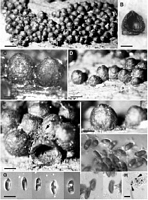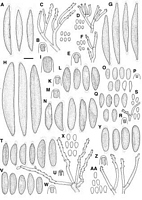|
 Rosellinia stenasca Rosellinia stenasca
BiostatusPresent in region - Indigenous. Non endemic
Images (click to enlarge)
Caption: Fig. 28 Rosellinia stenasca. A, C-F, Stromata, E showing subiculum (arrow); B, Vertical
section of stroma with attached perithecium; G, Ascospores; H
Caption: Fig. 8 A-D, Rosellinia arcuata, PDD 41969: A, Ascospores; B, Ascus apical ring; C,
Conidiophores and conidia on the host; D, Conidiophores and conidia on OA; E-G, R.
freycinetiae, PDD 20580: E, Ascus a | |
Article: Petrini, L.E. (2003). Rosellinia and related genera in New Zealand. New Zealand Journal of Botany 41(1): 71-138 (http://www.rsnz.org/publish/abstracts.php).
Description: Subiculum evanescent, brown, felty, remnants between brown stromata, black stromata free of
subiculum. Stromata (500)610 ± 72(700) µm high, (525)615 ± 58(675) µm wide (n = 5),
conical to columnar, with bluntly rounded top, dark brown to black, solitary, crowded,
touching each other. Ostioles finely papillate or not differentiated. Ectostroma 50 µm thick,
black. Entostroma not seen. Perithecia remaining attached to the stromatal wall. Ascus apical
rings 1.9-2.9 µm high, upper width 2.4-2.8 µm, lower width 1.9-2.8 µm (n = 5), J+, pale blue.
Ascospores (9.6)11 ± 0.6(11.5) µm long, (4.3)4.8 ± 0.3(5.3) µm wide (n = 30), ellipsoidal,
broadly rounded, light brown, with unclear, straight germ slit running over the whole spore
length, one 0.5 x 2 µm large semiglobose, cellular appendage on immature spores and
occasionally on mature ones.
ANAMORPH: Unknown.
Habitat: HOST: Undetermined.
MATRIX: Decorticated, heavily decomposed hardwood.
Notes: NOTES: Rosellinia stenasca has small ascospores for a Rosellinia. Its stromata are extremely
crowded and therefore laterally compressed to form a uniform layer. In young material a
subiculum is present and its remnants are still visible when mature, thus justifying the
placement of this species in Rosellinia (Fig. 28E). Two original specimens collected by Rick
held at FH and PACA (type) exhibit the same characteristics (L. E. Petrini unpubl. data). A
discriminant analysis of ascospore size revealed no differences between the South American
and the New Zealand collections (results not shown); the stroma size of the two species was
also similar. The germ slit, faintly visible on the ascospores of the New Zealand material,
could not be detected in either Rick collection. The age of the material and the very light
coloured ascospores might have obscured the slit.
Rosellinia breensis Starbäck, R. erianthi Chona & Munjal, and R. pardalios (Berk. &
M.A.Curtis) Cooke have ascospores of similar size as R. stenasca, but they are darker brown
and their stromata differ in shape and size, especially in height.
|